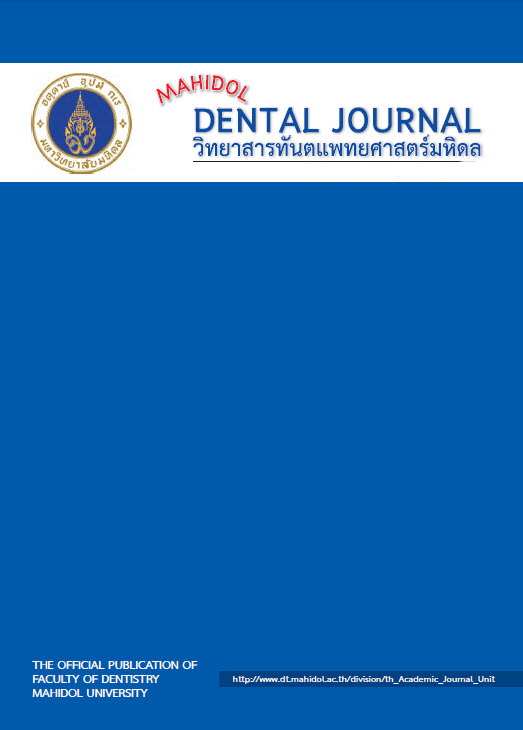Perceptions of Students and Instructors towards Relevance of Physics in Mahidol Dental Curriculum: A questionnaire survey
Main Article Content
Abstract
Objective: To explore the relevance of physics in Mahidol undergraduate dental curriculum based on perceptions of both instructors and students.
Materials and methods: The study employed a quantitative research method, using a paper-based questionnaire survey. The questionnaire contained questions regarding demographics, perceptions towards relevance of physics in dentistry, and self-perceived importance of physics in dental curriculum. The data were analyzed using descriptive statistics and Spearman’s rho.
Results: There were 341 (57.1%) dental undergraduates and 74 (52.1%) instructors who responded to the questionnaire. The most three relevant physics topics for dental curriculum rated by students were Introduction (physical quantity and applications of physics), Fluid mechanics, and Dynamics, whilst those rated by instructors were Basic quantum mechanics, Fluid mechanics, and Introduction. Instructors and students considered Prosthodontics and Orthodontics as relevant subjects to physics, whilst only the instructor group valued Oral and maxillofacial radiology and Implantology as relevant subjects. In addition, 76% of the students believed that content of physics learned in high school was sufficient for dental curriculum, however over a half of the instructors disagreed. Respondents from both students and instructors also believed physics should be used as a part of the dental school admission. From students’ view, the credits of physics courses should be deducted to three credits, and some topics should be excluded.
Conclusion: Physics is essential for dental curriculum. However, the current physics courses should be revised; a vertical integration and exclusions of irrelevant topics or topics overlapping with high school physics can be key factors for further curriculum improvements.
Article Details
References
2. Lynch C, Grant T, McLoughlin P, & Last J. The relevance of basic sciences in undergraduate medical education. Irish Journal of Medical Science. 2016; 185(1): 195-201.
3. Pangaro LN. The Role and Value of the Basic Sciences in Medical Education: The perspective of clinical education-students' progress from understanding to action. Medical Science Educator. 2010; 20: 307-13.
4. Woods NN, Brooks LR, & Norman GR. The value of basic science in clinical diagnosis: creating coherence among signs and symptoms. Medical Education. 2005; 39(1): 107-12.
5. Gabel AB. The Role of Physics in Dentistry. Journal of Applied Physics. 1941; 12(10): 712-7.
6. Komabayashi T, Raghuraman K, Raghuraman R, Toda S, Kawamura M, Levine SM, & Bird WF. Dental Education in India and Japan: Implications for U.S. Dental Programs for Foreign-Trained Dentists. Journal of Dental Education. 2005; 69(4): 461-9.
7. Jedrychowski J, & Lindemann R. Comparing Standardized Measures of Diligence and Achievement with Dental Student Academic Performance. Journal of Dental Education. 2005; 69(4): 434-9.
8. Komabayashi T, & Åstrom A. Dental education in Norway. European Journal of Dental Education. 2007; 11(4): 245-50.
9. Elangovan S, Allareddy V, Singh F, Taneja P, & Karimbux N. Indian Dental Education in the New Millennium: Challenges and Opportunities. Journal of Dental Education. 2010; 74(9): 1011-6.
10. Ihm J-J, Lee G, Kim K-K, Jang K-T, & Jin B-H. Who Succeeds at Dental School? Factors Predicting Students’ Academic Performance in a Dental School in Republic of Korea. Journal of Dental Education. 2013; 77(12): 1616-23.
11. Humphrey SP, Mathews RE, Kaplan AL, & Beeman CS. Undergraduate basic science preparation for dental school. Journal of Dental Education. 2002; 66(11): 1252-9.
12. Bucur MV, Shanley DB, & Claffey N. Contents of stomatological curricula in Europe. European Journal of Dental Education. 2006; 10(2): 61-6.
13. Wu ZY, Zhang ZY, Jiang XQ, & Guo L. Comparison of dental education and professional development between mainland China and North America. European Journal of Dental Education. 2010; 14(2): 106-12.
14. Komabayashi T, Srisilapanan P, Korwanich N, & Bird WF. Education of dentists in Thailand. International Dental Journal. 2007; 57(4): 274-8.
15. Arnold WH, Gonzalez P, & Gaengler P. The predictive value of criteria for student admission to dentistry. European Journal of Dental Education. 2011; 15(4): 236-43.
16. Shoosanglertwijit R, & Wangsaturaka D, editors. The relevance of physics in an undergraduate medical curriculum: Student's perspective. AMEE 2013; 2018 24-28 August 201; Plaque, Czech Republic.
17. Wootton DM, & Ku DN. Fluid Mechanics of Vascular Systems, Diseases, and Thrombosis. Annual Review of Biomedical Engineering. 1999; 1(1): 299-329.
18. Vignon-Clementel IE, Alberto Figueroa C, Jansen KE, & Taylor CA. Outflow boundary conditions for three-dimensional finite element modeling of blood flow and pressure in arteries. Computer Methods in Applied Mechanics and Engineering. 2006; 195(29): 3776-96.
19. Baier RE. Surface Behaviour of Biomaterials: The theta surface for biocompatibility. Journal of Materials Science: Materials in Medicine. 2006; 17(11): 1057.
20. Bidez MW, & Misch CE. Force Transfer in Implant Dentistry: Basic concepts and principles. Journal of Oral Implantology. 1992; 18(3): 264-74.
21. Wiskott HW, Nicholls JI, & Belser UC. Stress Fatigue: Basic principles and prosthodontic implications. The International journal of prosthodontics. 1995; 8(2): 105-16.
22. Şahin S, Çehreli MC, & Yalçın E. The Influence of Functional Forces on the Biomechanics of Implant-Supported Prostheses-A review. Journal of Dentistry. 2002; 30(7): 271-82.
23. Ren Y, Maltha JC, & Kuijpers-Jagtman AM. Optimum Force Magnitude for Orthodontic Tooth Movement: A systematic literature review. The Angle Orthodontist. 2003; 73(1): 86-92.
24. Taylor TD, Wiens J, & Carr A. Evidence-based considerations for removable prosthodontic and dental implant occlusion: A literature review. The Journal of Prosthetic Dentistry. 2005; 94(6): 555-60.
25. Badawi HM, Toogood RW, Carey JPR, Heo G, & Major PW. Three-Dimensional Orthodontic Force Measurements. American Journal of Orthodontics and Dentofacial Orthopedics. 2009; 136(4): 518-28.
26. Ling J, & Fu Y. Recent Changes in the Curriculum of Chinese Dental Schools. Journal of Dental Education. 2007; 71(11): 1447-56.
27. Christensen W, Johnson JK, Ness GRV, Mylott E, Dunlap JC, Anderson EA, Widenhorn R, & Brewe E. Developing and Assessing Curriculum on the Physics of Medical Instruments. CBE—Life Sciences Education. 2013; 12(2): 250-61.


